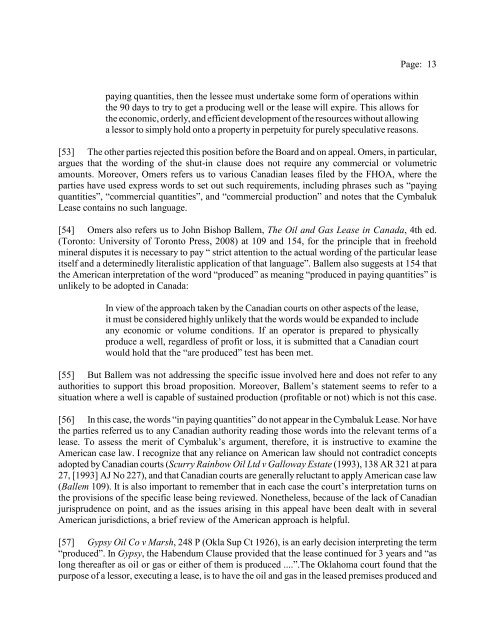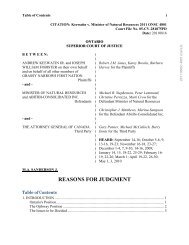Omers Energy Inc. v. Alberta (Energy Resources Conservation Board)
Omers Energy Inc. v. Alberta (Energy Resources Conservation Board)
Omers Energy Inc. v. Alberta (Energy Resources Conservation Board)
- No tags were found...
Create successful ePaper yourself
Turn your PDF publications into a flip-book with our unique Google optimized e-Paper software.
Page: 13paying quantities, then the lessee must undertake some form of operations withinthe 90 days to try to get a producing well or the lease will expire. This allows forthe economic, orderly, and efficient development of the resources without allowinga lessor to simply hold onto a property in perpetuity for purely speculative reasons.[53] The other parties rejected this position before the <strong>Board</strong> and on appeal. <strong>Omers</strong>, in particular,argues that the wording of the shut-in clause does not require any commercial or volumetricamounts. Moreover, <strong>Omers</strong> refers us to various Canadian leases filed by the FHOA, where theparties have used express words to set out such requirements, including phrases such as “payingquantities”, “commercial quantities”, and “commercial production” and notes that the CymbalukLease contains no such language.[54] <strong>Omers</strong> also refers us to John Bishop Ballem, The Oil and Gas Lease in Canada, 4th ed.(Toronto: University of Toronto Press, 2008) at 109 and 154, for the principle that in freeholdmineral disputes it is necessary to pay “ strict attention to the actual wording of the particular leaseitself and a determinedly literalistic application of that language”. Ballem also suggests at 154 thatthe American interpretation of the word “produced” as meaning “produced in paying quantities” isunlikely to be adopted in Canada:In view of the approach taken by the Canadian courts on other aspects of the lease,it must be considered highly unlikely that the words would be expanded to includeany economic or volume conditions. If an operator is prepared to physicallyproduce a well, regardless of profit or loss, it is submitted that a Canadian courtwould hold that the “are produced” test has been met.[55] But Ballem was not addressing the specific issue involved here and does not refer to anyauthorities to support this broad proposition. Moreover, Ballem’s statement seems to refer to asituation where a well is capable of sustained production (profitable or not) which is not this case.[56] In this case, the words “in paying quantities” do not appear in the Cymbaluk Lease. Nor havethe parties referred us to any Canadian authority reading those words into the relevant terms of alease. To assess the merit of Cymbaluk’s argument, therefore, it is instructive to examine theAmerican case law. I recognize that any reliance on American law should not contradict conceptsadopted by Canadian courts (Scurry Rainbow Oil Ltd v Galloway Estate (1993), 138 AR 321 at para27, [1993] AJ No 227), and that Canadian courts are generally reluctant to apply American case law(Ballem 109). It is also important to remember that in each case the court’s interpretation turns onthe provisions of the specific lease being reviewed. Nonetheless, because of the lack of Canadianjurisprudence on point, and as the issues arising in this appeal have been dealt with in severalAmerican jurisdictions, a brief review of the American approach is helpful.[57] Gypsy Oil Co v Marsh, 248 P (Okla Sup Ct 1926), is an early decision interpreting the term“produced”. In Gypsy, the Habendum Clause provided that the lease continued for 3 years and “aslong thereafter as oil or gas or either of them is produced ....”.The Oklahoma court found that thepurpose of a lessor, executing a lease, is to have the oil and gas in the leased premises produced and
















